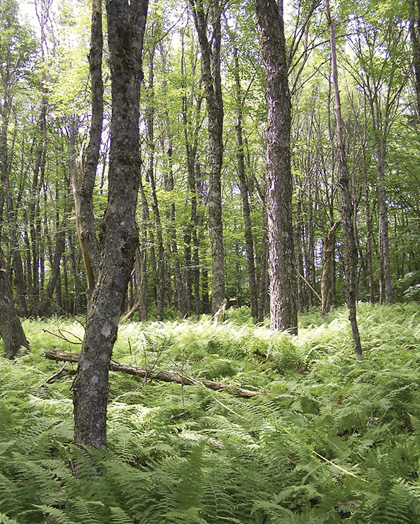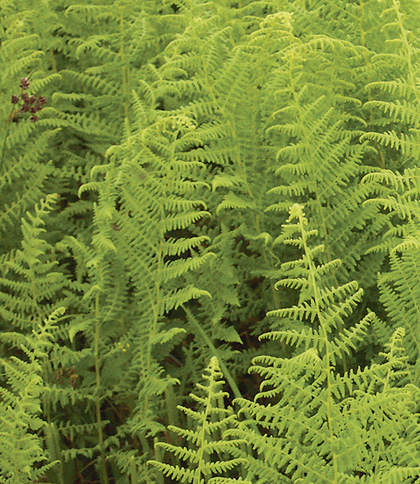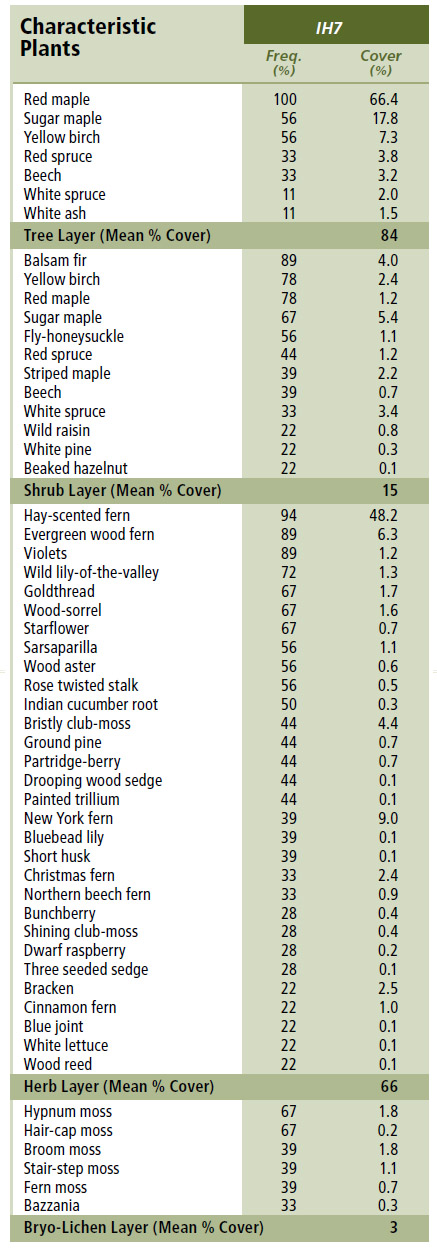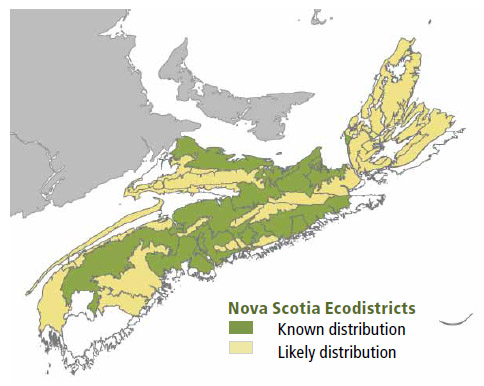
Forest Vegetation types - IH7
IH7 — Red maple / Hay-scented fern – Wood sorrel
Acer rubrum / Dennstaedtia punctilobula – Oxalis acetosella
 |
Tyndal Road, Cumberland County |
Concept: This early to mid-successional Vegetation Type (VT) has an overstory dominated by red maple and lesser amounts of several shade-tolerant associates, possibly including sugar maple, yellow birch and/or red spruce. IH7 is also distinguished by its diverse herb layer, which is indicative of mesic Nova Scotia hardwood forests. Red maple / Hay-scented fern – Wood sorrel usually follows stand-replacing disturbances events such as fire, windthrow or clearcutting, but it can also result from partial harvesting within hardwood forests.
Vegetation: Red maple is the dominant overstory tree, accompanied by a lesser amount of sugar maple, yellow birch, red spruce and/or beech. The shrub layer is moderately developed and includes regenerating trees (including balsam fir), fly-honeysuckle and striped maple. The herb layer is dominated by several species of ferns, most notably hay-scented fern which can be an aggressive competitor in open, disturbed sites. Other common species include New York fern, evergreen wood fern, rose twisted stalk, Indian cucumber root, wood aster, wood sorrel, bristly and shining club-moss, and various violet species. The bryophyte layer is poorly developed.
Environmental Setting: IH7 is associated with fresh to moist, nutrient medium to rich soils of variable texture. This VT is found scattered throughout Nova Scotia, but is particularly common on upper slope positions within the Nova Scotia Uplands ecoregion. This VT is common in New Brunswick and on Prince Edward Island. It is the most widespread red maple forest in the Maritimes.
Successional Dynamics: IH7 is an early to mid-successional VT that usually follows stand-level disturbance events in hardwood forests. The main disturbance agents are typically windthrow and harvesting, including aggressive partial harvesting, which can promote coppice red maple regeneration. The smothering and competitive nature of hay-scented fern can also restrict and/or delay establishment of other hardwood species. With sufficient time between disturbance events, IH7 can succeed to TH1 (Sugar maple / Hay-scented fern), TH2 (Sugar maple / New York fern – Northern beech fern), TH6 (Red oak – Yellow birch / Striped maple) or MW1 (Red spruce – Yellow birch / Evergreen wood fern).
Ecological Features: This early successional closed canopy hardwood forest typically develops following stand-level disturbance. Regeneration is by seed or coppice. The longevity and relatively high shade tolerance of red maple facilitate its persistence into later successional stages. Red maple regenerates quickly as coppice and is a favoured browse by both deer and moose. It flowers before most other spring plants, providing one of the most important early and abundant pollen and nectar sources used by a wide range of insects. With increased light availability caused by canopy disturbances, hay-scented fern can be very invasive and spread aggressively, which restricts tree regeneration.
 |
| Hay-scented fern |
Distinguishing Features: This hardwood forest on well drained soils is dominated by red maple. On better sites sugar maple, yellow birch and beech are present. Extensive hay-scented fern cover is diagnostic for this unit. New York fern and evergreen wood fern are also common.
| Slope Position: | Middle4 Upper3 Crest2 Level1 |
Surface Stoniness: |
(Non - Slightly)7 (Moderately)1 (Very - Excessively)1 nd1 |
Bedrock Outcrop: |
(Non-rocky)9 (Slightly - Moderately)1 |
Elevation Range: |
28 - 261m |
Slope Gradient: |
Gentle4 Moderate3 Level2 Steep1 |
Aspect: |
North4 East2 South1 West1 None1 nd1 |
Exposure: |
Moderate5 Mod. exposed4 Mod. sheltered1 |
Microtopography: |
Moderately4 Strongly4 Other2 |
Drainage: |
Moderately well5 Well5 |
Soil Type: |
ST2-L4 ST52 ST21 ST81 Other2 |
Parent Material: |
Glacial till10 |
Rooting Depth (cm): |
(30-45)4 (>45)6 |
Duff Thickness (cm): |
(0-5)2 (6-10)5 (11-20)1 (>40)1 nd1 |

